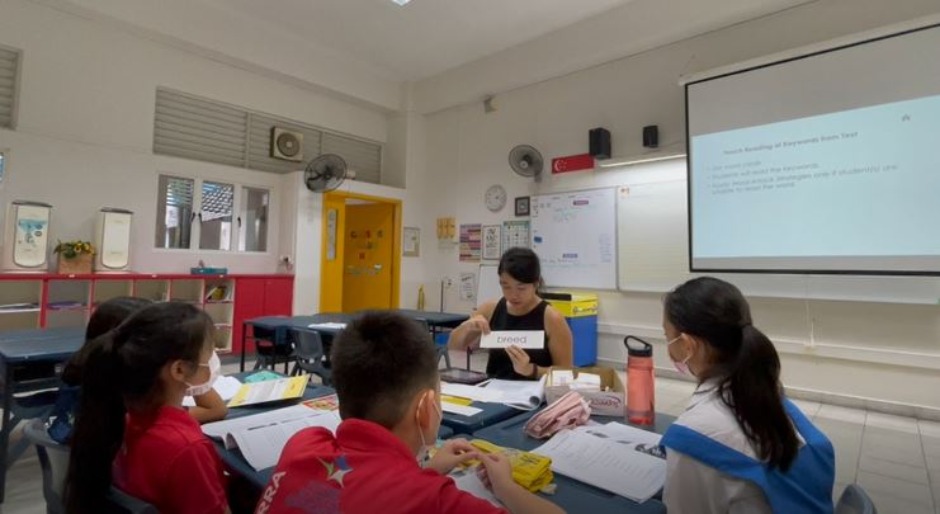Add Maths, Science and pumpkins and you get? Lessons plus a side of dessert
12 Jul 2023

Ms Lee Hui Ting, Year Head at Canberra Primary School and a Mathematics and Science educator, designs school experiences around real-life activities and her students’ interests, because it grows their confidence and motivates them for school.
Schoolbag speaks with the Outstanding Youth in Education Award (OYEA) 2023 finalist about her teaching inspirations and a pumpkin-growing project that has sweet rewards.
What inspires you to teach?
I often spend time during recess and after school to get to know my students better as individuals. I also use a mailbox for students to leave me notes to share their joy or concerns with me at any time.
One of my students, Peter*, was often seen staring out of the class window, or doodling on his worksheets during lesson time. What he did have a deep passion for was sports. So, I encouraged him to join a Sports CCA and the school’s sports programme. As I kept up contact to encourage him, I was really heartened when he stepped up to lead his team in different activities.
To motivate him in his lessons, I used sports analogies to explain certain difficult Maths and Science concepts, and invited him to share his thoughts and opinions in class. He started to show interest, even creating PowerPoint presentations to facilitate class discussions. Overjoyed, I shared Peter’s progress with his mother. In turn, she shared how she saw Peter researching and preparing the presentations all by himself, working the whole night to get it just right. He also offered to be part of the class organising committee for the Teacher’s Day concert, and put up a wonderful performance.
I am very proud to see how much he has grown over the year, into someone who is more confident of his abilities, who takes ownership of his learning, even volunteering to help his friends in their work. Eventually, he was nominated captain of his CCA.
My experience with this child has reinforced my belief that every child is unique and capable of success. And by creating a positive, nurturing and inclusive environment for our students to thrive in, we can help them get there.
*Not his real name
Describe a teaching approach you have found effective.
I often share stories to give my students a context they can relate to, to inspire them to believe in their own ability to grow and succeed. If they can see examples of resilience and a growth mindset in action, they can develop a greater sense of confidence and motivation to tackle challenges and failures.
When it was nearing the students’ NAPFA fitness test, I received letters in my mailbox from those who were worried about their first 1.6km long-distance run in their primary school years. Some were going to pretend to be unwell so that they could skip the run.
So, I shared with them the story The Girl Who Never Made Mistakes. It opened up conversations about the stress of perfection. My students shared how they understood that the protagonist was happy and enjoyed learning after she embraced failure. I also shared how I overcame my own challenges for the NAPFA test with them. Through role modelling, storytelling, and using questions to deepen learning, the students learnt how to keep things in perspective – to enjoy the process of doing what we do, to be resilient, and not be overly occupied with results and outcomes.
“Every child is unique and capable of success. And by creating a positive, nurturing and inclusive environment for our students to thrive in, we can help them get there.”
To further motivate them, I joined them in the field during one of their Physical Education lessons. I ran alongside the students, cheered them on and accompanied the last student across the finishing line. Despite feeling exhausted, all the students tried their best to complete the run. This scene was memorable, especially when they cheered one another on till the end. “Start Young, Start Right” is the name of our school’s Applied Learning Programme but also a statement I believe in, which is to nurture the right values in students from young. Stories are a good way to inculcate this.
Which school initiative are you especially proud of?
As the Year Head for the middle primary levels, I hold the work of developing holistic and purposeful student experiences close to my heart.
One such example is the pumpkin patch infused Curriculum Integration learning package which I lead in collaboration with the Science department.

In Primary 3, each class has its own plot of pumpkin plants. The students sow their own pumpkin seeds during Science lessons, and the teachers generate discussions on germination and pollination in the life cycle of the pumpkin plant. “Look, Ms Lee, there are female flowers. And look, there are male flowers over there too! Can cross pollination happen now?” I enjoy listening to their chatter around the pumpkin patch, including “Ms Lee, look at how big our class pumpkin has grown. I can’t wait to eat it!”
As part of their interdisciplinary learning, the students measure growth by plotting bar graphs using the Chartistics App for Maths lessons. They also conduct research about the pumpkin as a sustainable food during English lessons.
Thereafter, the students document their experience on their personal learning devices by vlogging. When some plants fail, students attempt to grow another batch of seeds – an occasion to discuss values such as trying hard and trying again in their daily lives.
To celebrate their learning and success, we harvest the pumpkins proudly together. Another highlight is when our canteen vendors cook the pumpkins in an improvised ‘bubur cha cha’ dessert! This dessert is then enjoyed by the whole cohort of P3 students and staff. It’s inter-disciplinary and authentic learning at its best – and most delicious – to me.





